Aid to the disabled
高二英语上册第8单元重点:First aid
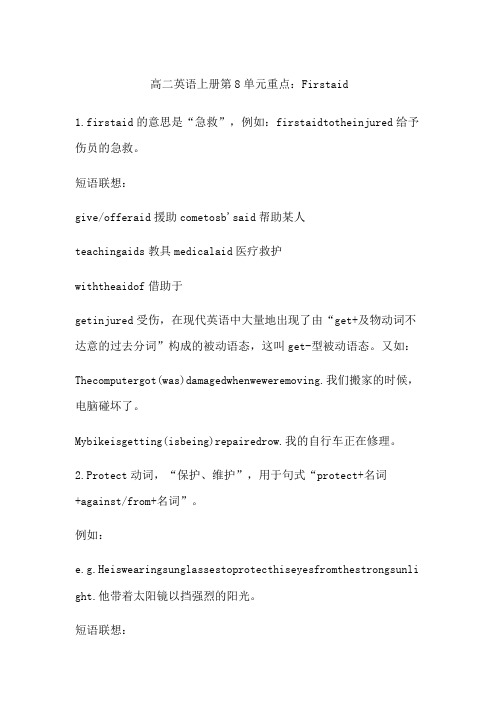
高二英语上册第8单元重点:Firstaid1.firstaid的意思是“急救”,例如:firstaidtotheinjured给予伤员的急救。
短语联想:give/offeraid援助cometosb'said帮助某人teachingaids教具medicalaid医疗救护withtheaidof借助于getinjured受伤,在现代英语中大量地出现了由“get+及物动词不达意的过去分词”构成的被动语态,这叫get-型被动语态。
又如:Thecomputergot(was)damagedwhenweweremoving.我们搬家的时候,电脑碰坏了。
Mybikeisgetting(isbeing)repairedrow.我的自行车正在修理。
2.Protect动词,“保护、维护”,用于句式“protect+名词+against/from+名词”。
例如:e.g.Heiswearingsunglassestoprotecthiseyesfromthestrongsunli ght.他带着太阳镜以挡强烈的阳光。
短语联想:Keep...from...不让/避免stop...(from)...阻止prevent...(from)...妨碍/防止disable...from...使……失去(能力/资格)save...from...挽救、拯救3.dependon取决于。
例如:e.g.Theamountyoupaydependsonwhereyoulive.你付多少取决于你住哪里。
词义拓展dependon依靠,依赖:Hisfamilydependsonhim.他的一家人全靠他养活。
依赖,信任:WearedependingonyoutofinishthejobbyFriday.我们相信你在星期五前能完成这项工作。
4.squeeze动词,意思是“榨取”、“挤出”,例如:squeezeanorange榨橘子常用句式squeeze+名词+out(of/from)+名词,例如:e.g.Thoseblackmailersintendedtosqueezemoremoneyoutofhim.那些勒索者打算向他榨取更多的钱。
Robots to aid the disabled and the elderly
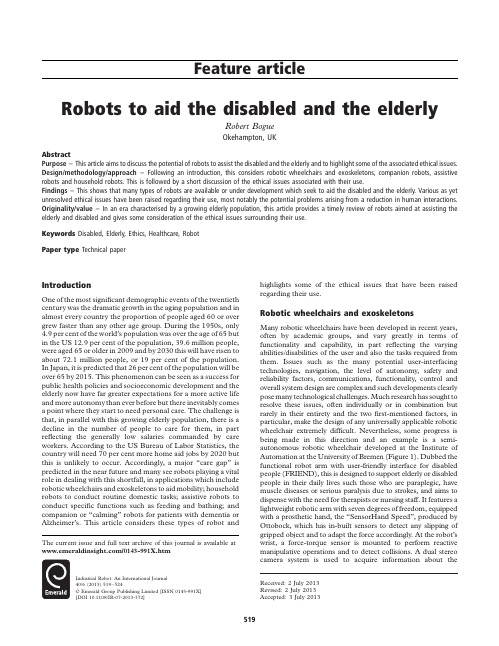
Feature articleRobots to aid the disabled and the elderlyRobert BogueOkehampton,UKAbstractPurpose–This article aims to discuss the potential of robots to assist the disabled and the elderly and to highlight some of the associated ethical issues. Design/methodology/approach–Following an introduction,this considers robotic wheelchairs and exoskeletons,companion robots,assistive robots and household robots.This is followed by a short discussion of the ethical issues associated with their use.Findings–This shows that many types of robots are available or under development which seek to aid the disabled and the elderly.Various as yet unresolved ethical issues have been raised regarding their use,most notably the potential problems arising from a reduction in human interactions. Originality/value–In an era characterised by a growing elderly population,this article provides a timely review of robots aimed at assisting the elderly and disabled and gives some consideration of the ethical issues surrounding their use.Keywords Disabled,Elderly,Ethics,Healthcare,RobotPaper type Technical paperIntroductionOne of the most significant demographic events of the twentieth century was the dramatic growth in the aging population and in almost every country the proportion of people aged60or over grew faster than any other age group.During the1950s,only 4.9per cent of the world’s population was over the age of65but in the US12.9per cent of the population,39.6million people, were aged65or older in2009and by2030this will have risen to about72.1million people,or19per cent of the population. In Japan,it is predicted that26per cent of the population will be over65by2015.This phenomenon can be seen as a success for public health policies and socioeconomic development and the elderly now have far greater expectations for a more active life and more autonomy than ever before but there inevitably comes a point where they start to need personal care.The challenge is that,in parallel with this growing elderly population,there is a decline in the number of people to care for them,in part reflecting the generally low salaries commanded by care workers.According to the US Bureau of Labor Statistics,the country will need70per cent more home aid jobs by2020but this is unlikely to occur.Accordingly,a major“care gap”is predicted in the near future and many see robots playing a vital role in dealing with this shortfall,in applications which include robotic wheelchairs and exoskeletons to aid mobility;household robots to conduct routine domestic tasks;assistive robots to conduct specific functions such as feeding and bathing;and companion or“calming”robots for patients with dementia or Alzheimer’s.This article considers these types of robot and highlights some of the ethical issues that have been raised regarding their use.Robotic wheelchairs and exoskeletonsMany robotic wheelchairs have been developed in recent years, often by academic groups,and vary greatly in terms of functionality and capability,in part reflecting the varying abilities/disabilities of the user and also the tasks required from them.Issues such as the many potential user-interfacing technologies,navigation,the level of autonomy,safety and reliability factors,communications,functionality,control and overall system design are complex and such developments clearly pose many technological challenges.Much research has sought to resolve these issues,often individually or in combination but rarely in their entirety and the twofirst-mentioned factors,in particular,make the design of any universally applicable robotic wheelchair extremely difficult.Nevertheless,some progress is being made in this direction and an example is a semi-autonomous robotic wheelchair developed at the Institute of Automation at the University of Bremen(Figure1).Dubbed the functional robot arm with user-friendly interface for disabled people(FRIEND),this is designed to support elderly or disabled people in their daily lives such those who are paraplegic,have muscle diseases or serious paralysis due to strokes,and aims to dispense with the need for therapists or nursing staff.It features a lightweight robotic arm with seven degrees of freedom,equipped with a prosthetic hand,the“SensorHand Speed”,produced by Ottobock,which has in-built sensors to detect any slipping of gripped object and to adapt the force accordingly.At the robot’s wrist,a force-torque sensor is mounted to perform reactive manipulative operations and to detect collisions.A dual stereo camera system is used to acquire information about theThe current issue and full text archive of this journal is available at /0143-991X.htmIndustrial Robot:An International Journal40/6(2013)519–524q Emerald Group Publishing Limited[ISSN0143-991X] [DOI10.1108/IR-07-2013-372]Received:2July2013Revised:2July2013Accepted:3July2013 519environment and is mounted at the top of the chair on a pan-tilt head unit behind the seat and an“intelligent”tray is positioned in front of the user,onto which objects can be placed by the manipulator.This features an IR proximity sensing technique to acquire information about object locations and IR technology is also used for communication with various appliances in the robot’s environment.The unit is located beneath the pan-tilt head and can,for example,activate an automatic door opening mechanism in a refrigerator or a microwave oven.Several interface devices are available or under development and include a chin joystick,a hand joystick,speech recognition,eye movement tracking and various brain-computer interface(BCI) technologies.The robot has allowed people to conduct a variety of tasks such as preparing and eating a meal.The image processing technology used in the FRIEND illustrates well just one of the complex issues associated with the development of this type of robot.It has to operate in an unstructured environment with variable lighting conditions and recognise objects within it. T o achieve this the robot uses a specially developed vision system termed robust machine vision for service robotics(ROVIS)which uses several methods for object recognition,e.g.region-based colour segmentation and edge detection.Thefirst is used for objects with uniform colour and without texture such as bottles, glass and handles and the second for objects with textures such as books.For large objects like a refrigerator or a microwave oven,an improved scale invariant feature transform(SIFT)algorithm is used,which was developed at the university.A schematic of the ROVIS system architecture is shown in Figure2. Exoskeletons have been considered in detail in a previous issue of this journal(Vol.36No.5)and are only discussed briefly here.They are powered devices which are worn by the user and in contrast to military applications,where they are intended to impart greater strength,they can be used in the medical context to enhance mobility.Most are used to assist in walking and several are now available commercially,for example the ReWalk from Argo Medical T echnologies and the robotic exoskeleton legs produced by Rex Bionics.The ReWalk is battery-powered and uses motorised legs that power knee and hip movement.It is controlled by on-board computers and motion sensors and a forward tilt of the upper body is sensed by the system,which triggers thefirst step.ReWalk controls movement using subtle changes in the center of gravity,mimics natural gait and provides functional walking speed.Rex Bionics is working with the University of Houston to develop a system whereby the legs could be operated by thought alone.The aim is to detect brain activity using EEG techniques and translate the electrical impulses into commands for the exoskeleton.Companion robotsThe concept is for robots to provide companionship to the elderly or disabled,notably those suffering from Alzheimer’s or other forms of cognitive impairment.An estimated25million people worldwide have Alzheimer’s disease and this number is expected to triple by2050.One of thefirst companion robots was the Wakamaru,a humanoid,wheeled robot which stands100cm high,made by Mitsubishi Heavy Industries and launched in2005 (Figure3).It has a limited voice recognition capability and also facial recognition and makes eye contact when“conversing”with an individual.It is equipped with ultrasonic and IR sensors and cameras which allows it to operate autonomously in an indoor environment.More widely publicised and perhaps more controversial is the Paro robot which resembles an immature harp seal(Figure4).Also developed in Japan,this is intended to have a calming effect on,and elicit emotional responses from, patients and act in a similar manner to animal-assisted therapy and is claimed to respond in a similar way to a live animal.It is equipped with a range of sensors which allow it to perceive people and its environment.With a light sensor,it can recognise light and dark and“feels”being stroked by the tactile sensor or being held by the posture sensor.Paro can also recognise the direction of voices and words such as its name,greetings and praise.It can learn to behave in a way that the user prefers;for example,if you stroke it every time you touch it,it will remember your action and try to repeat it to be stroked.About1,000Paros have been sold to nursing homes,hospitals and individual consumers in Japan and in Denmark,government health officials are trying to quantify its effect on blood pressure and other stress indicators.Since the robot went on sale in the USA late last year,a few elderly care facilities have purchased one and several dozen others have signed rental agreements with the manufacturer.A broadly similar product is the Genibo robotic puppy produced by Dongby Robot Co.in South Korea.This is available in several variants and the latest,the model SD,features face and voice recognition and according to the manufacturer it can express a full range of emotions as well as responding to touch. Assistive robotsThe aim of these is to help a patient conduct tasks that are difficult or impossible and a good example is the Cody robot,developed at the Healthcare Robotics Laboratory at Georgia Institute of T echnology.The robot(Figure5)is equipped with compliant arms that allows it to perform the wiping motions that are involved in bed baths.The area of skin to be cleaned is selected by the patient via a camera and a laser rangefinder and the robot then cleans it with the soapy bath mitt(Figure6),using a gentle wiping motion.The robot’s two anthropomorphic arms,whichFigure1The roboticFRIENDSource: Credit: Wikipedia520have seven degrees of freedom and wrists equipped with six-axis force/torque sensors,have joints with reduced stiffness to soften any accidental impacts.Wiping can be achieved using a relatively low force (,3N)and the robot is programmed never to exert a pressure capable of causing injury.The research team maintains that having a robot to carry out personal hygiene tasks such as bed baths for incapacitated patients may have advantages,such as giving the patient greater privacy and independence.Further,itFigure 2Schematic of the ROVIS imaging systemHuman-Machine InterfaceChin control Camera Pan-Tilt Head Stereo Images AcquisitionContainer DetectionROI DefinitionCamera CalibrationRobust Feature-Based 2D Recognition of Objects tobe Manipulated3D Object Reconstruction World ModelSpeech recognitionBCIUser InteractionROVIS HardwareROVIS InitializationOther Reactive OperationsROVIS Object Recognition and ReconstructionSource: Credit: WikipediaFigure 3The Wakamaru humanoidrobotSource: Credit: WikipediaFigure 4The Paro thetrapeutic seal-likerobotsSource: Credit: Wikipedia Figure 5The CodyrobotSource: Credit: Gerogia Tech521reduces the reliance on nurses or carers.The Healthcare Robotics Lab is also involved in the“Robots for Humanity”project, a collaboration between Willow Garage,Georgia T ech and the Man and Machines Group at Oregon State University.The work is based around the PR2robot produced by Willow Garage and the long-term aim is to put robots into homes to help people with severe disabilities.Much of the present work involves Henry Evans,a patient who is mute and quadriplegic,having suffered a stroke at the age ing a head tracker,Evans recently used the PR2to shave his cheek and the research group is actively investigating ways for him and others to perform such tasks on a daily basis.Further details of the human-robot interfacing technologies used in Cody and the Robots for Humanity project,together with a discussion of brain-machine interfacing, are given in a previous issue of this journal(Vol.40No.4).The inability of disabled people to feed themselves is one of the most common causes for the need for carers and several research groups are working on self-feeding robots.This is a complex issue due to the varying capabilities of the users and also because the type of food involved varies according to country and culture.An example of work aimed at a particular type of food is research by the Korea National Rehabilitation Research Institute.This involves a dual-arm robotic manipulator(Figure7)that can handle Korean food such as boiled,sticky rice in an ordinary food container.Koreans typically use a spoon and steel chopsticks,sometimes simultaneously,to eat and the robot’s two arms are equipped with different end effectors to mimic this eating behaviour.In the system,the gripper of a grab-arm and the spoon of a spoon-arm take on the roles of chopsticks and a spoon,respectively. The spoon-arm has two DOF in order to transfer food on the spoon without changing its orientation and the grab-arm includes a three-DOF SCARA joint for the planar motion,a one-DOF joint for the up and down motion and a gripper. Operation is by buttons on a touchpad or by joysticks,although in trials,many users preferred the dual joystick design.An EU-funded,collaborative project termed “CompanionAble”aims to develop a mobile robotic companion“Hector”which can work collaboratively in a smart home environment.Led by a group at the University of Reading, UK,this goes a step further than most assistive robots in that it integrates the robot with the home,allowing it to conduct functions such as closing curtains and windows,turning lights on and off or regulating the central heating,as well as monitoring potentially dangerous situations like using the stove or reporting when the individual leaves their home.In addition,it can remind a person when to take their medications or how to use the TV remote control.It will also monitor the individual and summon help from family members or medical professionals if,for example,they have a ers interact with Hector directly through voice and a large touch screen and it respond to verbal commands such as“follow me”or“go to the kitchen”. CompanionAble systems have been installed in a number of demonstration homes which are being used to test and improve the wide range of functions developed by the project through long-term studies with real elderly care recipients.Final trials and demonstrations are presently underway in Belgium,Spain, France and The Netherlands.Household robotsHousehold or domestic robots conduct tasks around the home and act as convenience items for able-bodied users but also have a role to play in assisting less mobile individuals.T o date,relatively few have been commercialised and the best known is the robotic vacuum cleaner.Thefirst was the Trilobite,launched by Electrolux in2001but the Roomba series(Figure8),produced by iRobot and introduced in2002is perhaps the best known,with over six million having been sold worldwide.It is powered by removable nickel/metal hydride batteries which are recharged from a wall adaptor.Newer models have a self-charging homebase which they automatically try tofind at the end of a cleaning session via IR beacons.Four IR“cliff sensors”on the bottom of the robot prevent it from falling off ledges such as the top of stairways.Most second and third generation models have internal acoustic dirt sensors that allow them to detect particularly dirty spots and focus on those areas and fourth generation models have an optical sensor located in front of the vacuum bin to detect wider or smaller areas to clean.Many Roombas are now supplied with IR remote controls,allowing a human operator to“drive”them to specific areas.An allied type of product is thefloor cleaning robot,for example iRobot’s Scooba range,which can clean wooden, tiled or linoleumfloors.Robotic lawn mowers are also widely available.All manner of other domestic robots are the topic or research or at the development stage,including those that can load and unload dishwashers,load washing machines,prepare food,dust and collect waste.Figure6The soapymittSource: Credit: Georgia Tech522Ethical considerationsThis article has only touched on the many robotic devices that are aimed at assisting the elderly and disabled but it is evident that many appear to have the potential to improve a patient’s quality of life and autonomy.A sophisticated robot wheelchair clearly offers advantages over a conventional device and a robotic vacuum cleaner or self-feeding robot must surely also be beneficial.While they certainly reduce the need for human carers and thus address one of the key problems associated with a growing elderly population,they also remove valuable opportunities for social interaction:is this beneficial?Research has shown that a reduction in human contact and social interaction has a negative effect on both the physical and psychological well-being of the elderly.Further,it has been found that decreased social engagement from mid-to late-life is associated with an increased risk of dementia.It has been suggested that social interaction reduces the risk of dementia by reducing stress and consequently by reducing the levels of hormones associated with stress.Social and physical activity may also help because it increases a person’s ability to tolerate brain pathology.The extent to which reduced or missing human contact can be compensated for by interaction with companion robots is not yet fully understood but in any event,the technology is not without its critics.Sherry Turkle,a professor of science, technology and society at MIT conducted a series of studies with Paro and was troubled when she saw a76-year old woman share stories about her life with the robot.She said:I felt like this isn’t amazing;this is sad.We have been reduced to spectatorsof a conversation that has no meaning.Giving old people robots to talk to isa dystopian view that is being classified as utopian.Figure7The assistive robot for self-feedingGrab-arm (Arm #2)GripperGripperTray SpoonSpoon-Arm (Arm #1)Source: Credit: Song and Kim (2012)Figure8The iRobot robotic vacuumcleanerSource: Credit: Wikipedia523Professor Turkle emphasised that robots do not have a capacity to listen or understand something personal and tricking patients into thinking that they can is unethical. Questions have also been raised as to whether certain assistive robots are actually designed to help the elderly or merely to cut costs and reduce their carers’workload.Robots designed as replacements for nurses or carers that carry out some of the same tasks,such as feeding or bathing,may make patients feel that they have even less control over their lives than when they are dependent on human care.These are all complex, multidisciplinary issues whose resolution is more likely to arise from psychological studies than technological innovation. However,a further area of concern is of a more technological nature:while a patient may atfirst have the dexterity to operate a joystick or the cognitive capacity to remember how to issue a specific voice command,this may not be the case at a later date when their condition deteriorates,leading to frustration,stress and disolutionment.Thus,interfacing technologies need to be developed which areflexible and able to adapt to changing user capabilities.ReferenceSong,W.-K.and Kim,J.(2012),Novel Assistive Robot for Self-Feeding,Robotic Systems–Applications,Control and Programming,edited by Dutta,A.,InT ech,available at:www. /books/robotic-systems-applications-control-and-programming/novelassistive-robot-for-self-feeding Corresponding authorRobert Bogue can be contacted at:robbogue@T o purchase reprints of this article please e-mail:reprints@ Or visit our web site for further details:/reprints524。
Unit5FirstAid单元重点归纳清单高中英语人教版选择性
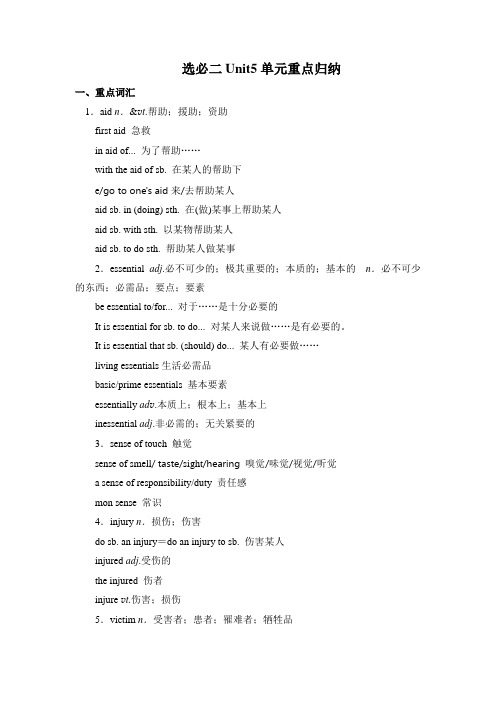
选必二Unit5单元重点归纳一、重点词汇1.aid n.&v t.帮助;援助;资助first aid 急救in aid of... 为了帮助……with the aid of sb. 在某人的帮助下e/go to one's aid来/去帮助某人aid sb. in (doing) sth. 在(做)某事上帮助某人aid sb. with sth. 以某物帮助某人aid sb. to do sth. 帮助某人做某事2.essential adj.必不可少的;极其重要的;本质的;基本的n.必不可少的东西;必需品;要点;要素be essential to/for... 对于……是十分必要的It is essential for sb. to do... 对某人来说做……是有必要的。
It is essential that sb. (should) do... 某人有必要做……living essentials生活必需品basic/prime essentials 基本要素essentially ad v.本质上;根本上;基本上inessential adj.非必需的;无关紧要的3.sense of touch 触觉sense of smell/ taste/sight/hearing 嗅觉/味觉/视觉/听觉a sense of responsibility/duty 责任感mon sense 常识4.injury n.损伤;伤害do sb. an injury=do an injury to sb. 伤害某人injured adj.受伤的the injured 伤者injure v t.伤害;损伤5.victim n.受害者;患者;罹难者;牺牲品accident/earthquake victims事故/地震的罹难者AIDS/cancer victims艾滋病/癌症患者fall victim to... 成为……的牺牲品/受害者6.urgent adj.紧急的;急迫的;急切的urge v.力劝;敦促;强烈要求n.强烈的愿望urge sb. on 鼓励某人;为某人加油urge sb. to do sth. 敦促某人做某事urge sth. on/upon sb. 极力主张某人某事;向某人敦促某事urge that... 主张……It is urged that... (should) do sth. 坚决要求……做某事。
读写任务----the disabled

读写任务 ---How to write a summary
Main idea
B7U1 Living well
Retell Marty’s story with about 30 words
文章是关于一个残疾的孩子,马帝.菲尔丁的. 虽然他患有肌肉疾病,但是仍然有一个积极的生活态度, 并且努力克服困难,学会独立,过上了和正常人一样丰富 而充实的生活.
残疾人的现状
我们应该怎样对待残疾人:
帮助残疾人的意义
1.表达看法的句型:
• • • • • • • • I think…/ I believe… I think it necessary to…/that… I think it important to…/that… There is no doubt that… As far as I am concerned,… In my opinion,… From my point of view,… I can’t agree more with the writer that…
Marty’s advice :Para 5
Don’ts feel sorryfor Don’t __________ the disabled
Don’t _____________ make fun of them ignore them Don’t _________
Dos ________ accept them for who they are Give themencouragement __________ to live as rich and full a life as you do
Write a summary after reading the following passage
高二英语Unit8词汇学习

高二英语Unit8词汇学习1. aidvt.1.) 帮助,救助,支援 [(+in/with)]She made no effort to aid Sophia.她根本不去帮助索菲娅。
2.) 有助于A good dictionary can aid language learning.一部好词典有助于语言学习。
vi.帮助n.1.) 帮助,救助,援助[U]He should be able to read this without the aid of a dictionary. 他应当能够不用字典就读懂这个。
2.) 帮助者;助手[C]3.) 有辅助作用的事物[C]a visual aid视觉教具4.) 助听器[C]2. drownvt.1.) 把...淹死She fell overboard and was drowned.她从船上掉入水中淹死了。
2.) 淹没,浸湿3.) (声音等)压过,盖过[(+out)]The noise of the machines drowned his voice.机器声将他的声音淹没了。
4.) 解(忧愁等)It is no use trying to drown your sorrows in drink. 想借酒浇愁于事无补。
vi.1.) 溺死2.) 沉没;浸没The boat drowned.船沉没了。
3. bleed/ bled/ bledvi.1.) 出血,流血He was bleeding badly.他流了很多血。
2.) 悲伤;心疼My heart bleeds for you.我衷心同情你。
4. chokevt.1.) 使窒息;哽住The child was almost choked by the heavy smoke. 这孩子几乎被浓烟窒息了。
2. )堵塞,阻塞[(+up/with)]The storeroom was choked with furniture.储藏室塞满了家具。
高二英语上学期unit 8 language points
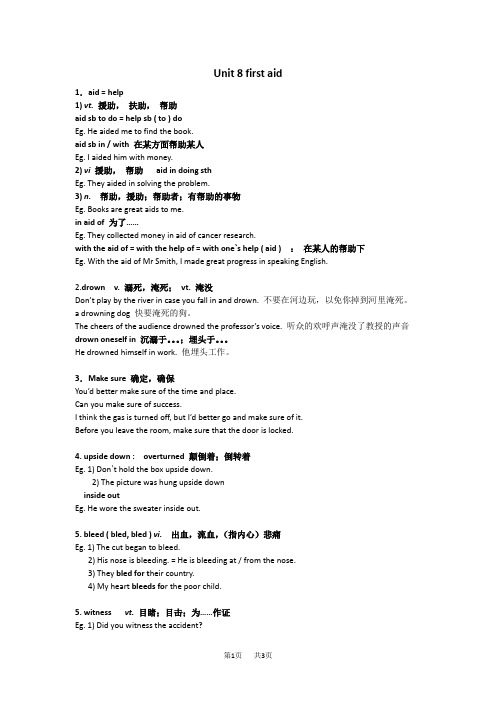
Unit 8 first aid1.aid = help1) vt.援助,扶助,帮助aid sb to do = help sb ( to ) doEg. He aided me to find the book.aid sb in / with 在某方面帮助某人Eg. I aided him with money.2) vi 援助,帮助aid in doing sthEg. They aided in solving the problem.3) n.帮助,援助;帮助者;有帮助的事物Eg. Books are great aids to me.in aid of 为了……Eg. They collected money in aid of cancer research.with the aid of = with the help of = with one`s help ( aid ) :在某人的帮助下Eg. With the aid of Mr Smith, I made great progress in speaking English.2.drown v. 溺死,淹死;vt. 淹没Don’t play by the river in case you fall in and drown. 不要在河边玩,以免你掉到河里淹死。
a drowning dog 快要淹死的狗。
The cheers of the audience drowned the professor’s voice. 听众的欢呼声淹没了教授的声音drown oneself in 沉溺于。
;埋头于。
He drowned himself in work. 他埋头工作。
3.Make sure 确定,确保You’d better make sure of the time and place.Can you make sure of success.I think the gas is turned off, but I’d better go and make sure of it.Before you leave the room, make sure that the door is locked.4. upside down : overturned 颠倒着;倒转着Eg. 1) Don`t hold the box upside down.2) The picture was hung upside downinside outEg. He wore the sweater inside out.5. bleed ( bled, bled ) vi. 出血,流血,(指内心)悲痛Eg. 1) The cut began to bleed.2) His nose is bleeding. = He is bleeding at / from the nose.3) They bled for t heir country.4) My heart bleeds fo r the poor child.5. witness vt.目睹;目击;为……作证Eg. 1) Did you witness the accident?2) He witnessed the truth of my statement.witness to 为……作证;出庭证明;证实,其中to 是介词,后接名词或动名词Eg. She witnessed to seeing that man take the money.n.证据,目击者Eg. The police found the witness to the murder case.6. count vi 有价值;重要;有用Eg. 1) Every minute counts. 每一分钟都很重要。
(人教版)高二英语上册第8单元复习知识点:First aid
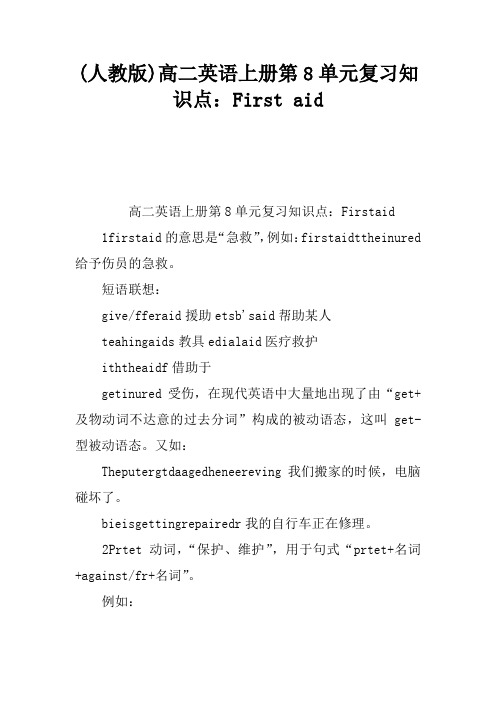
(人教版)高二英语上册第8单元复习知识点:First aid高二英语上册第8单元复习知识点:Firstaid 1firstaid的意思是“急救”,例如:firstaidttheinured 给予伤员的急救。
短语联想:give/fferaid援助etsb'said帮助某人teahingaids教具edialaid医疗救护iththeaidf借助于getinured受伤,在现代英语中大量地出现了由“get+及物动词不达意的过去分词”构成的被动语态,这叫get-型被动语态。
又如:Theputergtdaagedheneereving我们搬家的时候,电脑碰坏了。
bieisgettingrepairedr我的自行车正在修理。
2Prtet动词,“保护、维护”,用于句式“prtet+名词+against/fr+名词”。
例如:egHeisearingsunglassestprtethiseesfrthestrngsunligh t他带着太阳镜以挡强烈的阳光。
短语联想:eepfr不让/避免stp阻止prevent妨碍/防止disablefr使……失去savefr挽救、拯救3dependn取决于。
例如:egTheauntupadependsnhereulive你付多少取决于你住哪里。
词义拓展dependn依靠,依赖:Hisfaildependsnhi他的一家人全靠他养活。
依赖,信任:earedependingnutfinishthebbFrida我们相信你在星期五前能完成这项工作。
4squeeze动词,意思是“榨取”、“挤出”,例如:squeezeanrange榨橘子常用句式squeeze+名词+ut+名词,例如:egThseblaailersintendedtsqueezereneutfhi那些勒索者打算向他榨取更多的钱。
verandveragain再三地。
例如:I’vetlduverandveragainnttdthat 我再三告诫你不要那样做。
词根词缀记忆字典
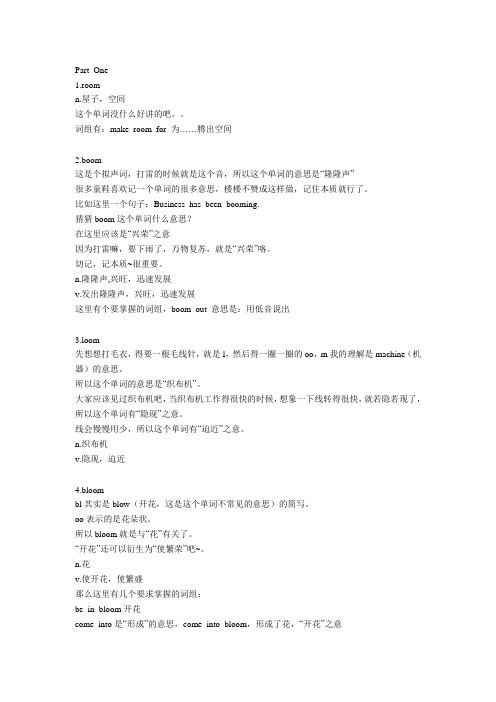
Part One1.roomn.屋子,空间这个单词没什么好讲的吧。
词组有:make room for 为……腾出空间2.boom这是个拟声词,打雷的时候就是这个音,所以这个单词的意思是“隆隆声”很多童鞋喜欢记一个单词的很多意思,楼楼不赞成这样做,记住本质就行了。
比如这里一个句子:Business has been booming.猜猜boom这个单词什么意思?在这里应该是“兴荣”之意因为打雷嘛,要下雨了,万物复苏,就是“兴荣”咯。
切记,记本质~很重要。
n.隆隆声,兴旺,迅速发展v.发出隆隆声,兴旺,迅速发展这里有个要掌握的词组,boom out 意思是:用低音说出3.loom先想想打毛衣,得要一根毛线针,就是l,然后得一圈一圈的oo,m我的理解是machine(机器)的意思。
所以这个单词的意思是“织布机”。
大家应该见过织布机吧,当织布机工作得很快的时候,想象一下线转得很快,就若隐若现了,所以这个单词有“隐现”之意。
线会慢慢用少,所以这个单词有“迫近”之意。
n.织布机v.隐现,迫近4.bloombl其实是blow(开花,这是这个单词不常见的意思)的简写。
oo表示的是花朵状。
所以bloom就是与“花”有关了。
“开花”还可以衍生为“使繁荣”吧~。
n.花v.使开花,使繁盛那么这里有几个要求掌握的词组:be in bloom开花come into是“形成”的意思,come into bloom,形成了花,“开花”之意那么有“开花”就也有“落花”be out of bloomin the bloom of,在开花期,就是“最佳时期”,比如我们说The night before a test is in t he bloom of studying.意思就是“考试前一天的晚上是我们学习的最佳时期,临时抱佛脚可不行的噢~”5.broom大家看扫帚的形状像不像“b”?b就是扫帚的形状room房间打扫房间的工具,就是扫帚咯~n.扫帚有一句俗语叫:新官上任三把火A new broom sweeps well.大家要会说哦~Part Two1.zipz这个字母有点难理解,大家想象下拉拉链的时候发出的音是不是和z一样,就是“zizizi~”这样的音?当拉链向上拉的时候,也会有“pu”这个音。
人教高中必修5 unit5-first-aid-单词

• 高手过招 • (1)单项填空 • His efforts to raise money for his program were because no one showed any intention to take a cent out of their pockets. • A. in place B. in sight • C. in effect D. in vain • (2)完成句子 • ①你可以用木柴来取代煤。 • You can use wood coal. • ②棉花要取代丝绸。 • Cotton is silk. • ③你的提议很恰当。 • Your proposal is quite . • 解析:(1) 选D。考查介词短语。in vain(白费力)。in place 在适当位置;in sight 在视线内;in effect 实际上。 • (2)①in place of ②taking the place of • ③in place
• 高手过招 • 单句改错 • ①The family lived on government aids for two years. • ②We may travel on/under the aid of a good map. • ③We’ve aided him finish the work ahead of time. • 答案:①aids→aid ②on/under→with • ③finish→to finish或in finishing
• • • • • • • • • • • • • •
7. in place 在适当的位置;适当 I like everything to be in place. 我喜欢所有的东西都放在原来的地方。 With everything in place, she started the slide show. 一切就绪,她开始放幻灯片。 联想拓展 out of place 不在适当的位置; 不合适 be in/out of order 有条理/无条理;坏 了 be in/out of control 正常/失控 be in/out of danger 有危险/脱离危险 in place of...=take the place of... 代替;取代 give place to 被……取代;让位 于……
高中英语作文素材 关于如何帮助残疾人的 How to take care of the disabled people
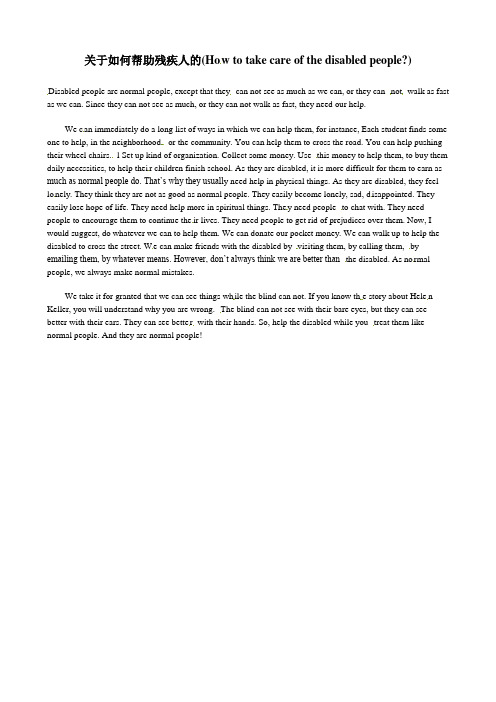
关于如何帮助残疾人的(How to take care of the disabled people?)Disabled people are normal people, except that they can not see as much as we can, or they can not walk as fast as we can. Since they can not see as much, or they can not walk as fast, they need our help.We c an immediately do a long list of ways in which we can help them, for instance, Each student finds some one to help, in the neighborhood or the community. You can help them to cross the road. You can help pushing their wheel chairs.l Set up kind of organization. Collect some money. Use this money to help them, to buy them daily necessities, to help their children finish school. As they are disabled, it is more difficult for them to earn as much as normal people do. That’s why they usuall y need help in physical things. As they are disabled, they feello nely. They think they are not as good as normal people. They easily become lonely, sad, d isappointed. They easily lose hope of life. They need help more in spiritual things. They need people to chat with. They need people to encourage them to continue the ir lives. They need people to get rid of prejudices over them. Now, I would suggest, do whatever we can to help them. We can donate our pocket money. We can walk up to help the disabled to cross the street. We can make friends with the disabled by visiting them, by calling them, by emailing them, by whatever means. However, don’t always think we are better than the disabled. As no rmal people, we always make normal mistakes.We take it for granted that we can see things while the blind can not. If you know th e story about Hele n Keller, you will understand why you are wrong. The blind can not see with their bare eyes, but they can see better with their ears. They can see better with their hands. So, help the disabled while you treat them like normal people. And they are normal people!。
人教版必修五 Unit 5 First aid知识点

人教版必修五Unit 5 First aid知识点1.aid n.& v t.帮助;援助;资助(1)give sb.first aid/give first aid to sb.对某人进行急救in aid of为了援助with the aid of在……的帮助下(2)aid sb.in (doing) sth.在(做) 某事方面帮助某人aid sb.with sth.以某事/物帮助某人aid sb.to do sth.帮助某人做某事完成句子①________________our English teacher,we have made great progress this term.在英语老师的帮助下,这学期我们已经取得了巨大的进步。
②The moment he saw the poor girl on TV,he determined to________________ continuing her study.在电视上一看到这名可怜的女孩,他就决定要帮助她完成学业。
答案:①With the aid of②aid her in2. vital adj.至关重要的;生死攸关的be vital to/for对……至关重要It is vital to do sth.做某事很重要It is vital that...(should) do sth.……是十分重要的(从句用虚拟语气,should可以省略)完成句子/单句语法填空①As far as I'm concerned,________________accurate records.就我个人而言,做好准确的记录非常重要。
②It's vital that we________(carry) out the operation immediately.③Consideration for other people is vital ________ all of us.答案:①it is vital to keep②(should) carry③to/for3. treat v t.& v i.治疗;对待;款待n.款待;招待(1)treat sb.for sth.治疗某人某病treat sb.like/as...把某人当……看待treat sth.seriously认真对待某事treat oneself to吃……;享受It's my treat.我请客。
新人教选修七 Unit 1 Living well-Reading[课件]
![新人教选修七 Unit 1 Living well-Reading[课件]](https://img.taocdn.com/s3/m/54f42fddb14e852458fb572a.png)
7. Answer the questions on P4 Ex4.
Answers:
1. He does a lot of things, such as writing, computer programming, going to the movies and football matches with friends, looking after his pets and having a lot of study. 2. Don’t feel sorry for the disabled or make fun of them, and don’t ignore them either. Just accept them for who they are and give them encouragement to live as rich and full a life as you do. 3. Because they can see the real person inside Marty’s body. Also, Marty’s active and positive life style has made them changed their conduct towards Marty.
幼时患病,两耳失聪,双目失明。七岁 时,安妮· 沙利文担任她的家庭教师,从此成 了她的良师益友,相处达50年。在沙利文帮 助之下,进入大学学习,以优异成绩毕业。 在大学期间,写了《我生命的故事》,讲述 她如何战胜病残,给成千上万的残疾人和正 常人带来鼓舞。这本书被译成50种文字,在 世界各国流传。以后又写了许多文字和几部 自传性小说,表明黑暗与寂静并不存在。后 Helen Keller 来凯勒成了卓越的社会改革家,到美国各地, 到欧洲、亚洲发表演说,为盲人、聋哑人筹 海伦· 凯勒 美国盲聋女作家 集资金。二战期间,又访问多所医院,慰问 失明士兵,她的精神受人们崇敬。1964年被 教育家 授于美国公民最高荣誉–总统自由勋章,次年 又被推选为世界十名杰出妇女之一。
怎样守护残障人士英语作文
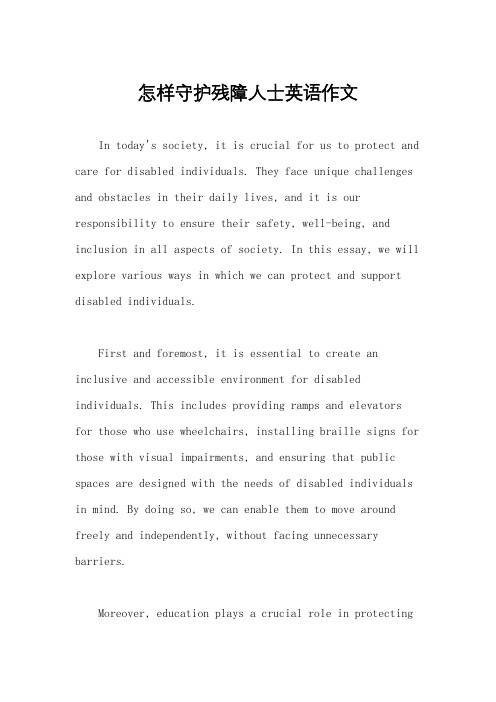
怎样守护残障人士英语作文In today's society, it is crucial for us to protect and care for disabled individuals. They face unique challenges and obstacles in their daily lives, and it is our responsibility to ensure their safety, well-being, and inclusion in all aspects of society. In this essay, we will explore various ways in which we can protect and support disabled individuals.First and foremost, it is essential to create an inclusive and accessible environment for disabled individuals. This includes providing ramps and elevatorsfor those who use wheelchairs, installing braille signs for those with visual impairments, and ensuring that public spaces are designed with the needs of disabled individuals in mind. By doing so, we can enable them to move around freely and independently, without facing unnecessary barriers.Moreover, education plays a crucial role in protectingdisabled individuals. It is important to provide equal educational opportunities for all, regardless of their disabilities. This includes ensuring that schools are equipped with the necessary resources and facilities to accommodate disabled students. Additionally, teachers should receive training on how to effectively teach and support disabled students, so they can thrive academically and socially.In addition to education, employment opportunities should be made available to disabled individuals. Many disabled individuals are capable of contributing to the workforce and leading fulfilling lives. By providing job opportunities and eliminating discrimination in the workplace, we can empower disabled individuals to become economically independent and enhance their self-esteem.Furthermore, it is important to promote understanding and empathy towards disabled individuals in society. This can be achieved through awareness campaigns, public events, and media representation. By raising awareness about the challenges faced by disabled individuals, we can foster amore inclusive and accepting society, where they aretreated with respect and dignity.Another critical aspect of protecting disabled individuals is ensuring their access to healthcare services. Disabled individuals often have unique medical needs, andit is important to provide them with appropriate medical care and support. This includes accessible healthcare facilities, specialized medical professionals, andaffordable healthcare options. By doing so, we can ensure that disabled individuals receive the necessary medical attention and support to maintain their health and well-being.Lastly, it is important to involve disabled individuals in decision-making processes that affect their lives. Their voices and perspectives should be heard and valued. By including them in discussions and policies that impact them, we can ensure that their rights and interests are protected.In conclusion, protecting and caring for disabled individuals is a collective responsibility. By creating aninclusive environment, providing equal educational and employment opportunities, promoting understanding and empathy, ensuring access to healthcare services, and involving disabled individuals in decision-making processes, we can work towards a society that values and supports allof its members, regardless of their abilities. It is only through such efforts that we can truly protect and empower disabled individuals, enabling them to live fulfilling and independent lives.。
aid的用法和辨析
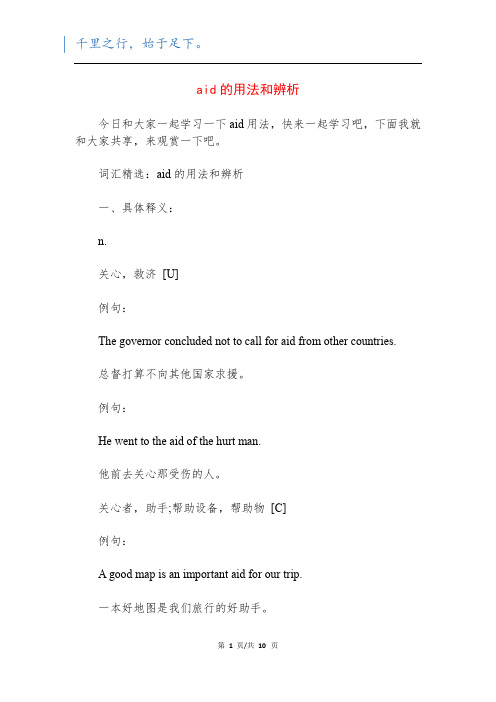
aid的用法和辨析今日和大家一起学习一下aid用法,快来一起学习吧,下面我就和大家共享,来观赏一下吧。
词汇精选:aid的用法和辨析一、具体释义:n.关心,救济[U]例句:The governor concluded not to call for aid from other countries.总督打算不向其他国家求援。
例句:He went to the aid of the hurt man.他前去关心那受伤的人。
关心者,助手;帮助设备,帮助物[C]例句:A good map is an important aid for our trip.一本好地图是我们旅行的好助手。
例句:A dictionary is an important aid in learning a language. 词典是学习语言的重要助手。
v.关心,救济[I,T]例句:The criminal was aided by an accomplice.罪犯得到了一个同谋的关心。
例句:Toms uncle aided him in getting a new job.汤姆的叔叔帮他找一个新工作。
有助于[T]例句:A good dictionary can aid language learning.一部好词典有助于语言学习。
二、词义辨析:help,aid,assistance,support这些名词均有“关心,支持”之意。
help最一般用词,可以与aid 和assistance换用。
help强调使受助者达到目的或侧重受助者对关心的需要。
aid比help正式,侧重受助者处于困难或危急境地急需救助。
assistance正式用词,通常指关心完成不太重要的那一部分工作。
support强调在迫切需要时赐予支持或鼓舞。
三、词义辨析:aid,assist,help这些动词均有“关心”之意。
aid正式用词,指关心他人脱离危急或战胜困难,着重强者对急需关心的弱者的关心。
高二英语unit-8-first-aid-word-P

高中英语第二册上Unit 8 First aid Period 4
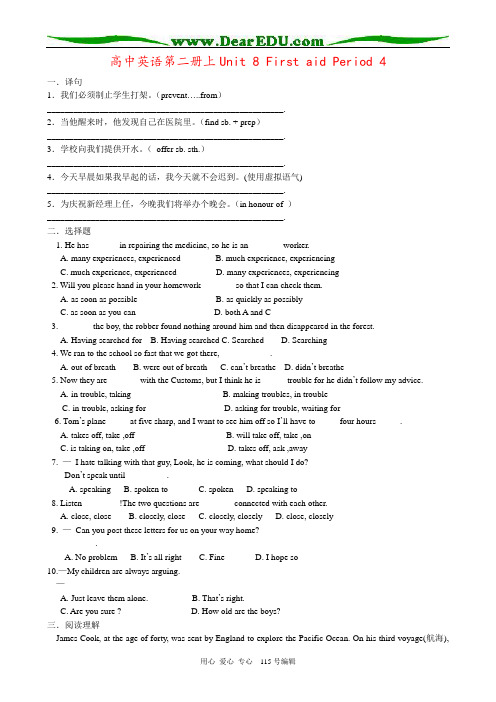
高中英语第二册上Unit 8 First aid Period 4一.译句1.我们必须制止学生打架。
(prevent…..from)______________________________________________________.2.当他醒来时,他发现自己在医院里。
(find sb. + prep)______________________________________________________.3.学校向我们提供开水。
(offer sb. sth.)______________________________________________________.4.今天早晨如果我早起的话,我今天就不会迟到。
(使用虚拟语气)______________________________________________________.5.为庆祝新经理上任,今晚我们将举办个晚会。
(in honour of )______________________________________________________.二.选择题1. He has ______ in repairing the medicine, so he is an _______ worker.A. many experiences, experiencedB. much experience, experiencingC. much experience, experiencedD. many experiences, experiencing2. Will you please hand in your homework _______ so that I can check them.A. as soon as possibleB. as quickly as possiblyC. as soon as you canD. both A and C3. _______ the boy, the robber found nothing around him and then disappeared in the forest.A. Having searched forB. Having searchedC. SearchedD. Searching4. We ran to the school so fast that we got there, ___________.A. out of breathB. were out of breathC. can’t breatheD. didn’t breathe5. Now they are_______ with the Customs, but I think he is _____ trouble for he didn’t follow my advice.A. in trouble, takingB. making troubles, in troubleC. in trouble, asking forD. asking for trouble, waiting for6. Tom’s plane _____at five sharp, and I want to see him off so I’ll have to_____ four hours _____.A. takes off, take ,offB. will take off, take ,onC. is taking on, take ,offD. takes off, ask ,away7. —I hate talking with that guy, Look, he is coming, what should I do?Don’t speak until _________.A. speakingB. spoken toC. spokenD. speaking to8. Listen ________!The two questions are _______ connected with each other.A. close, closeB. closely, closeC. closely, closelyD. close, closely9. —Can you post these letters for us on your way home?_______.A. No problemB. It’s all rightC. FineD. I hope so10.—My children are always arguing.—____________A. Just leave them alone.B. That’s right.C. Are you sure ?D. How old are the boys?三.阅读理解James Cook, at the age of forty, was sent by England to explore the Pacific Ocean. On his third voyage(航海),as captain of two ships, the Discovery and The Revolution, he came upon a group of unknown islands which he named the Sandwich islands after his friend, the Earl(伯爵)of Sandwich. Today the islands are known at the Hawaiian Islands.When Cook sailed into a protected bay(海湾)of one of the larger islands. The native greeted him with curiosity and respect. Some historians said that the islanders, welcomed him, believing he was the god, protector of peace and agriculture.The islanders were short, strong people with a very well-organized social system. The man fished and raised crops. The women prepared for the children and made clothing for the men and short skirts for the women.1. The islands were named ______A. the Hawaiian Islands by James CookB. the Earl of Sandwich by James CookC. Discovery by James CookD. the Sandwich Island by James Cook2. When he landed there James Cook found the islanders were_______A. coldB. friendlyC. warmD. kind3. Which of the following is true?A.The natives were tall and healthyB.The men mainly worked outsideC.The women did nothing but look after childrenD. The native were very curious about everything.四.书面表达假如你叫杨莉,请根据下面这则广告写一封求职信。
援助的英文单词
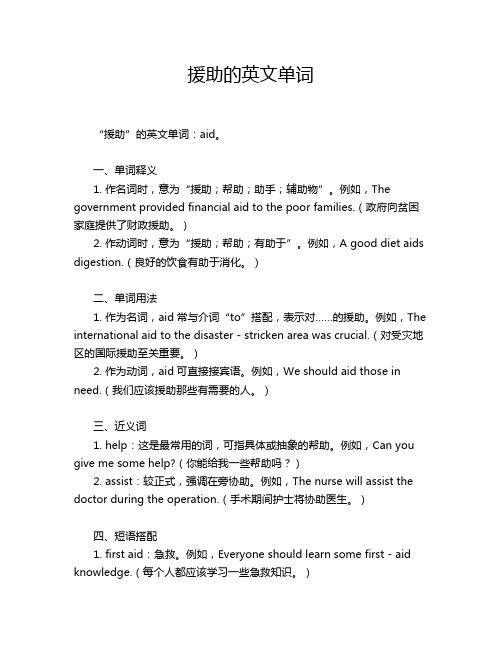
援助的英文单词“援助”的英文单词:aid。
一、单词释义1. 作名词时,意为“援助;帮助;助手;辅助物”。
例如,The government provided financial aid to the poor families.(政府向贫困家庭提供了财政援助。
)2. 作动词时,意为“援助;帮助;有助于”。
例如,A good diet aids digestion.(良好的饮食有助于消化。
)二、单词用法1. 作为名词,aid常与介词“to”搭配,表示对……的援助。
例如,The international aid to the disaster - stricken area was crucial.(对受灾地区的国际援助至关重要。
)2. 作为动词,aid可直接接宾语。
例如,We should aid those in need.(我们应该援助那些有需要的人。
)三、近义词1. help:这是最常用的词,可指具体或抽象的帮助。
例如,Can you give me some help?(你能给我一些帮助吗?)2. assist:较正式,强调在旁协助。
例如,The nurse will assist the doctor during the operation.(手术期间护士将协助医生。
)四、短语搭配1. first aid:急救。
例如,Everyone should learn some first - aid knowledge.(每个人都应该学习一些急救知识。
)2. in aid of:用以援助……。
例如,They are having a concert in aid of the homeless.(他们正在举办一场音乐会以援助无家可归者。
)3. with the aid of:借助……。
例如,With the aid of modern technology, we can solve many problems.(借助现代技术,我们可以解决很多问题。
英语小故事共30篇-英语小趣事
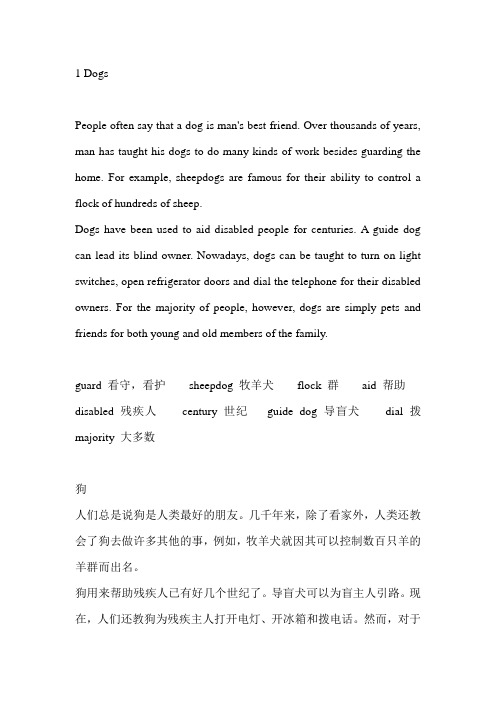
1 DogsPeople often say that a dog is man's best friend. Over thousands of years, man has taught his dogs to do many kinds of work besides guarding the home. For example, sheepdogs are famous for their ability to control a flock of hundreds of sheep.Dogs have been used to aid disabled people for centuries. A guide dog can lead its blind owner. Nowadays, dogs can be taught to turn on light switches, open refrigerator doors and dial the telephone for their disabled owners. For the majority of people, however, dogs are simply pets and friends for both young and old members of the family.guard 看守,看护sheepdog 牧羊犬flock 群aid 帮助disabled 残疾人century 世纪guide dog 导盲犬dial 拨majority 大多数狗人们总是说狗是人类最好的朋友。
几千年来,除了看家外,人类还教会了狗去做许多其他的事,例如,牧羊犬就因其可以控制数百只羊的羊群而出名。
狗用来帮助残疾人已有好几个世纪了。
导盲犬可以为盲主人引路。
现在,人们还教狗为残疾主人打开电灯、开冰箱和拨电话。
然而,对于大多数人来说,狗只是家里老人和孩子们的宠物和朋友。
高中英语作文:关爱残疾人Taking Care of The Disable
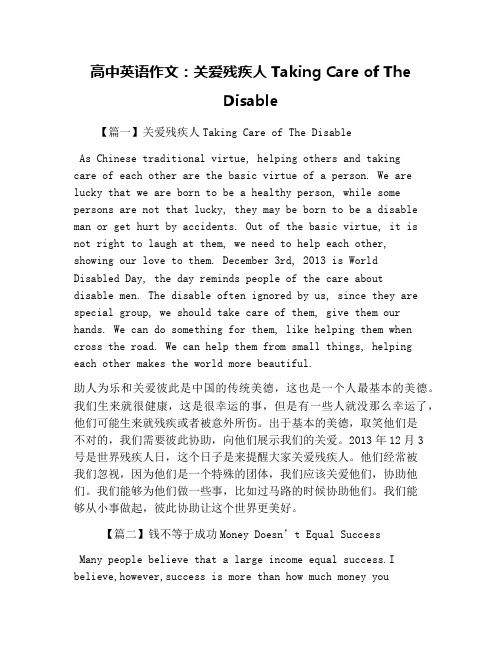
高中英语作文:关爱残疾人Taking Care of TheDisable【篇一】关爱残疾人Taking Care of The DisableAs Chinese traditional virtue, helping others and takingcare of each other are the basic virtue of a person. We are lucky that we are born to be a healthy person, while some persons are not that lucky, they may be born to be a disable man or get hurt by accidents. Out of the basic virtue, it is not right to laugh at them, we need to help each other, showing our love to them. December 3rd, 2013 is WorldDisabled Day, the day reminds people of the care aboutdisable men. The disable often ignored by us, since they are special group, we should take care of them, give them our hands. We can do something for them, like helping them when cross the road. We can help them from small things, helping each other makes the world more beautiful.助人为乐和关爱彼此是中国的传统美德,这也是一个人最基本的美德。
